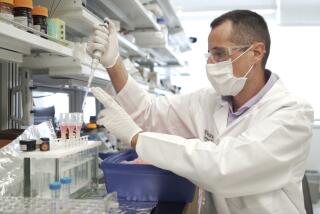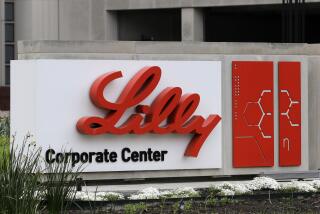Finding on Alzheimerâs May Be Key
Scientists at Amgen have isolated an elusive brain chemical believed to play a crucial role in the development of Alzheimerâs disease. Reporting their findings in todayâs edition of Science, the researchers hope the discovery will lead to targeted treatments that can halt the advance of this mind-devouring disease that afflicts an estimated 4 million Americans.
The investigators at the Thousand Oaks firm found the chemical--an enzyme that occurs in normal and diseased brain cells--by conducting a massive, automated search through tens of thousands of genes that occur in brain tissue.
Blocking the enzyme, scientists say, might prevent the progress of the disease in the same way that reducing cholesterol has been shown to blunt the ravages of heart disease.
But experts in the field caution that the leap from discovery to effective treatment could take years, and there is plenty of competition.
Still, the finding is a striking example of the power of the biotechnology industry to harness the genetic engineering revolution in the search for root causes of disease. In the past, such basic research was largely the domain of university scientists, but increasingly biotech companies are weighing in and producing encouraging results.
In this case, the ingenuity and resources of the largest biotech company, armed with the most advanced equipment available, proved critical in a race among a number of research teams to find the enzyme.
Researchers believe that the enzyme breaks down a large protein into smaller pieces--one of which, after further trimming, becomes amyloid, the fragment that accumulates in the brains of Alzheimerâs patients and is thought to destroy healthy brain tissue.
âWe had to do a huge number of experiments and that was only doable with automation,â said Martin Citron, one of the coauthors of the Science paper, who moved to Amgen in 1997 from Harvard Medical School. Of the 24 authors listed, all but one--David B. Teplow, a collaborator from Harvard--is at Amgen.
Citron and other scientists familiar with the work are careful to avoid claiming that they are close to a cure for the disease, which leaves patients increasingly forgetful and helpless as it progresses.
âObviously this does not translate into a treatment tomorrow,â Citron said. âBut it is a good start.â
The next step is to sift through large numbers of possible drugs to identify those that can block the enzyme and see if any can alter the course of the disease. But because any drug that blocks a naturally occurring compound might also have unexpected side effects, extensive testing will be required in animals before any are tried in patients.
The report was nevertheless hailed as a significant advance by experts in the field. An accompanying news article in the scientific journal notes that at least a dozen teams have been searching for the chemical isolated at Amgen.
Although company officials will not confirm that they are seeking patent protection for the discovery, it is routine to do so. And a patent could give Amgen a solid footing in a highly competitive and potentially profitable field.
Dr. Jeffrey L. Cummings, director of UCLAâs Alzheimerâs Disease Center, described the reported findings as an important step in testing the idea that blocking the formation of amyloid plaques can stop the damage to the patientsâ brains.
âIâm excited to hear this,â he said. âItâs an important step in testing the amyloid hypothesis. . . . If the hypothesis is correct, this could lead us in the direction of better therapies.â
Cummings said that biotech companies have been in the forefront of Alzheimerâs research. âThe range of places where science is done has expanded,â he said. âItâs part of the molecular revolution.â
Alzheimerâs disease is the most common cause of mental deterioration among the elderly--usually striking after the age of 65. The disease is named for Alois Alzheimer, a German physician, who first observed peculiar changes in the brain tissue of a woman who died of a strange mental malady.
Decades later, the cause of the disease remains unsettled, but a number of researchers believe that an excess of a protein--the amyloid found in those fibrous clumps in the patientsâ brains--is responsible.
In recent years, scientists have shown that the amyloid is produced when a pair of enzymes cut out the protein from an even longer compound, which plays a role in the health of normal brain cells. Researchers at a number of centers have been trying to isolate one or both of those enzymes.
The Amgen team is the first to report doing so in a major scientific journal. And their results are quite convincing, said Dr. Dennis Selkoe, a professor of neurology at Harvard Medical School and a leading researcher in this area. Selkoe believes he has found the second of the two Alzheimer enzymes, but has yet to prove that he has done so. Amgenâs Citron trained in Selkoeâs laboratory.
Amgenâs approach was a gamble--requiring a lot of time and effort and the possibility that in the end they would come up empty-handed, Selkoe said.
To find the enzyme, the Amgen team inserted all of the active human genes, a hundred at a time, into cells grown in the laboratory. Then the scientists separated out the cells that were making extra amounts of the amyloid protein. Eventually, the scientists were able to identify a single gene responsible for the increase in amyloid.
To prove they had the right gene and the right enzyme, they also had to show that blocking the gene reduced the normal production of amyloid and that the enzyme did its job at just the right place inside the cell to produce the kind of damage seen in Alzheimerâs.
Selkoe said that the evidence presented in the Science paper is convincing proof that Amgen has the right enzyme.
The job ahead is to find safe drugs that can block the enzyme, based on the idea that reducing amyloid production will prevent or slow Alzheimerâs, Selkoe said.
Several companies, Selkoe noted, are already working on drugs that appear to reduce amyloid production--even before the isolation of the key enzymes. But none has yet been tested in patients, Selkoe said.
Drugs now approved for Alzheimerâs are only marginally effective, but the potential market for improved products to screen and treat the disease is enormous--in excess of $2 billion a year, according to an estimate by SG Cowen.
The Science article was released late in the trading day Thursday. Shares in Amgen closed down $6 at $80.13 on Nasdaq.






